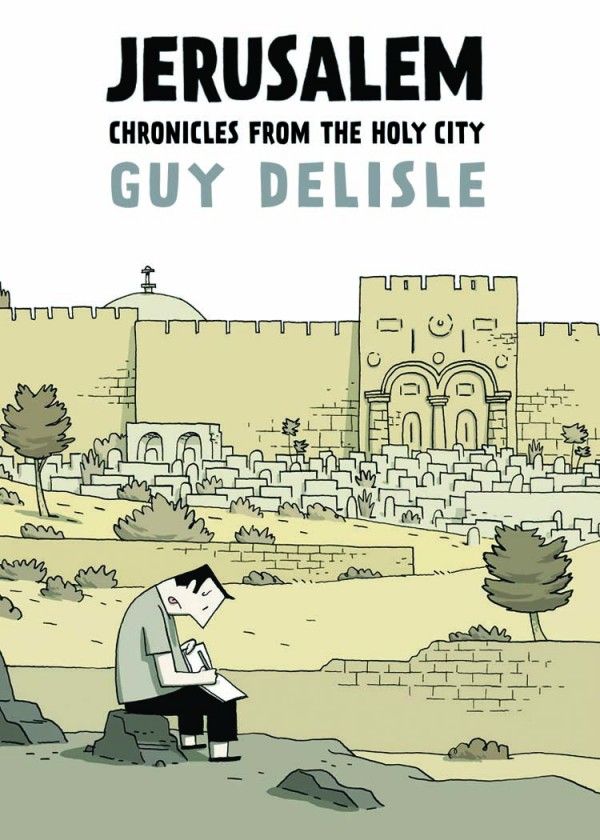Jerusalem: Chronicles From the Holy City
by Guy Delisle
Drawn and Quarterly, 320 pages, $24.95
Best of Enemies: A History of U.S. and Middle East Relations, Part One 1783-1953
by Jean-Pierre Filiu and David B.
Self Made Hero, 120 pages, $24.95
Perhaps it's just the tenor of the times (quite likely) or perhaps it's the influence of Joe Sacco (not quite as likely but still a possibility) but there's been a lot of graphic novels focusing on the Middle East lately. In the realm of fiction there's Craig Thompson's Habibi, G. Willow Wilson and M.K. Perker's Cairo and the various works of Marjane Satrapi. In the realm of nonfiction, there's Sacco's own Footnotes from Gaza. and Sarah Glidden's How to Understand Israel in 60 Days or Less. Now two new books have joined the conversation on the nonfiction side of things: Guy Delisle's Jerusalem and Best of Enemies, from historian Jean-Pierre Filiu and Epileptic author David B.
Jerusalem follows a path that will be familiar to anyone who's read any of Delisle's previous comics (apart from Albert and the Others and Aline and the Others): facts and background about the country he's visiting mixed in with quotidian examples of day-to-day life, usually in humorous fashion with Delisle portraying himself in a somewhat self-effacing, occasionally clueless fashion.
This time Delisle's wife's job with Doctors Without Borders takes them to the heart of much of the turmoil in the Middle East, the city of Jerusalem. Far from a city of wonder, Delisle is shocked to find how dirty and garbage-strewn Jerusalem is and lacking in infrastructure, at least on the Palestinian side of things. Much of the book is filled with Delisle wandering about the city and the outlying areas, making sketches and talking to denizens that hail from a variety of cultures and backgrounds.
Delisle doesn't delve too deep into the whys and wherefores of the Palestinian situation, no doubt assuming most readers understand the two sides' positions and issues regarding things like the Jewish settlements. Indeed, this is one of Delisle's subtlest graphic novels to date. His sympathies clearly ally with the Palestinians, but rather than use a sledge hammer to get his points across, Delisle relies on small observations: the thin hungry wrists of a woman in his cartooning seminar, or the way everyone seems to casually carry assault rifles. More often than not he simply presents a situation and allows the reader to draw their own conclusions.
If there's an overall enemy in Jerusalem, it's not Israel but organized religion. The book is filled with squabbling sects of various monotheistic religions, each one eager to place their own concerns and traditions ahead of the others, or of general decency. Even different sects of the same religion, like the various groups of Christians that run the Holy Sepulchre, seem incapable of getting along. A Lutheran minister, a comics fan who owns copies of Hellsing and gives Delisle a small studio space, provide a contrast to the zealotry that surrounds the city, but he's a lone voice of sanity in a city suffocating with extremists. Despite Delisle's considerable dry wit this might be his darkest, saddest travelogue book yet, and that's saying something for a man that's been to North Korea.
Best of Enemies, meanwhile, is not a contemporary book but a historical one -- a look back at relations between America and the Middle East over several centuries and how they have and have not changed. Filiu and B. score a hit right out the outset by retelling a segment of the Gilgamesh fable but inserting quotes from George W. Bush and Donald Rumsfeld in the mouths of the main characters, letting you know that this is not a book that will shy away from offering an opinion.
There have been a lot of these sort of "comics explains it all for you" historical graphic novels lately and I've begun to despair at the sight of them, mainly for their literal-mindedness and refusal to offer anything more than a brief, shallow synopsis on their chosen subject. Thank goodness for David B. then. Whereas a lazier cartoonist might see fit to illustrate what the text describes in the most obvious, unimaginative way possible, David B. lets his imagination run wild, so that characters' limbs turn into oil pipelines, a shah's turban becomes an ocean, with ships sailing across it, and cannons grow legs.
And then there are the fight scenes, which are handed with with the artist's usual aplomb -- he's captures violence and action with an incredible fury and I'm kind of amazed more people don't swipe from him. Really, as fascinating as these stories of 18th century battles with Barbary pirates and the coup that put the Shah of Iran back in power (and these stories are fascinating, make no mistake) David B. is the real draw here. His art serves as a reminder and stern rebuke to lax publishers and artists about how to properly bring history to life.


